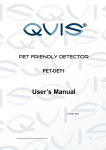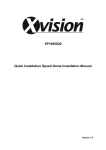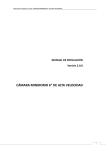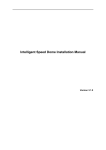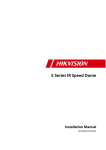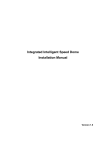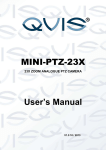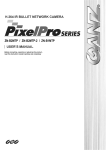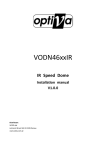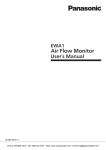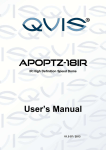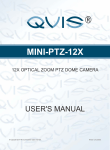Download APOHD-PTZ20 Manual
Transcript
APOHD-PTZ20 1080P HD PTZ Speed Dome User’s Manual V1.0 10 / 2013 © Copyright Qvis® All documentation rights reserved. i Welcome Thank you for purchasing the APOHD-PTZ20 Speed Dome. This user’s manual is designed to be a reference tool for the installation and operation of your system. Here you can find information about the corresponding IP camera’s features and functions, as well as a detailed installation method. Before installation and operation please read the following safeguards and warnings carefully! © Copyright Qvis® All documentation rights reserved. ii Table of Contents 1 FEATURES AND FUNCTIONS ................................................................................................ 1 1.1 General Introduction............................................................................................................................................. 1 1.2 Features .............................................................................................................................................................. 1 1.3 Specifications ....................................................................................................................................................... 2 2 QUICK INSTALLATION SPEED DOME INSTALLATION ......................................................... 4 2.1 Installation Preparation ........................................................................................................................................ 4 2.2 Installation ............................................................................................................................................................ 5 2.2.1 Address and Baud Rate Setup ........................................................................................................................ 5 2.2.2 Install the transparent cover ............................................................................................................................ 6 2.2.3 Install the speed dome ..................................................................................................................................... 7 2.3 Initial Setup .......................................................................................................................................................... 9 2.4 Dial Switch Setup ................................................................................................................................................. 9 2.4.1 Communication protocol and Baud rate .......................................................................................................... 9 2.4.2 Address Setup ............................................................................................................................................... 10 3 BRACKET DIMENSIONS ....................................................................................................... 11 3.1 Wall mount bracket ............................................................................................................................................ 11 3.2 Hanging mount bracket (Multiple Lengths) ........................................................................................................ 12 3.3 Corner mount bracket ........................................................................................................................................ 12 3.4 Pole mount bracket ............................................................................................................................................ 13 4 WALL MOUNT BRACKET INSTALLATION............................................................................ 14 © Copyright Qvis® All documentation rights reserved. iii 4.1 Component Installation ...................................................................................................................................... 14 4.2 Installation .......................................................................................................................................................... 14 4.2.1 Installation Requirements .............................................................................................................................. 14 4.2.2 Installation Steps ........................................................................................................................................... 14 5 HANG MOUNT BRACKET INSTALLATION ........................................................................... 16 5.1 Component Installation ...................................................................................................................................... 16 5.2 Installation .......................................................................................................................................................... 16 5.2.1 Installation Requirements .............................................................................................................................. 16 5.2.2 Installation Steps ........................................................................................................................................... 16 6 CORNER MOUNT BRACKET INSTALLATION ...................................................................... 19 6.1 Component Installation ...................................................................................................................................... 19 6.2 Installation .......................................................................................................................................................... 19 6.2.1 Installation Requirements .............................................................................................................................. 19 6.2.2 Installation Steps ........................................................................................................................................... 19 7 POLE MOUNT BRACKET INSTALLATION ............................................................................ 21 7.1 Installation .......................................................................................................................................................... 21 7.1.1 8 Installation Requirements .............................................................................................................................. 21 QUICK CONFIGURATION TOOL ........................................................................................... 24 8.1 Overview ............................................................................................................................................................ 24 8.2 Operation............................................................................................................................................................ 24 9 9.1 WEB OPERATION ................................................................................................................. 27 Network Connection ........................................................................................................................................... 27 © Copyright Qvis® All documentation rights reserved. iv 9.2 Login and Logout ............................................................................................................................................... 27 10 APPENDIX ABOUT RS485 BUS ........................................................................................... 30 10.1 RS485 Bus Main Feature ................................................................................................................................... 30 10.2 RS485 Bus Transmission Distance ................................................................................................................... 30 10.3 The Problem in Practical Use ............................................................................................................................ 30 10.4 RS485 Bus FAQ ................................................................................................................................................. 31 6 FAQ ........................................................................................................................................... 32 10.5 Daily Maintenance ............................................................................................................................................ 32 10.6 Problems and Solutions .................................................................................................................................. 32 © Copyright Qvis® All documentation rights reserved. v Important Safeguards and Warnings 1.Electrical safety All installation and operation here should conform to your local electrical safety codes. We assume no liability or responsibility for all the fires or electrical shock caused by improper handling or installation. We are not liable for any problems caused by unauthorized modification or attempted repair. 2.Transportation Security No heavy stress, violent vibration or contact with water is allowed during transportation, storage and installation. Please use the original packing material (or the material of the same quality) when you ship it back to the manufacturer. 3.Installation Do not apply power to the product before completing installation. Do not put object(s) on the product. 4.Environment This product should be installed in a cool, dry place away from direct sunlight, inflammable, explosive substances and etc. Please keep it away from environments that contain electromagnetic radiation or objects that produce it. Please keep sound ventilation around the device at all times. Do not allow the water and other liquid to penetrate into the device if casing has been compromised. This series product complies with the IP66 standard specified in the Degrees of Protection Provided by Enclosure. Please make sure the CCD (CMOS) component is away from the radiation of the laser beam device. Otherwise it may result in CCD (CMOS) optical component damage. 5. Daily Maintenance Current series product has no power button. Please unplug all corresponding power cables before your begin installation or daily maintenance work. Please keep the dustproof cap back to protect the CCD or CMOS part if the device does not work for a long time. Do not touch CCD (CMOS) component. You can use the blower to clean the dust on the surface of the device. You can use the dry cloth with some alcohol or mild detergent to clear if necessary. Do not use volatility solvent such as the benzene or thinner, or detergent with strong abradability. It may result in lens damage or it may adversely affect the device performance. © Copyright Qvis® All documentation rights reserved. vi If there is too much dust, please use the water to dilute the mild detergent first and then use it to clean the device. Finally use the dry cloth to clean the device. 6. About Accessories Always use all the accessories recommended by manufacturer. Before installation, please open the package and check that all the components are included in the package. Contact your local retailer ASAP if something is missing in your package. © Copyright Qvis® All documentation rights reserved. vii 1 Features and Functions 1.1 General Introduction This network camera integrates traditional camera and network video technology. It adopts both audio and video data collection and transmission simultaneously. Because of inbuilt internal hardware it can connect to a network directly without any auxiliary device. When you want to access the camera, you can use a web browser running off the network at the client-end. Due to its multiple functions it allows for various use in many environments such office, bank, road & traffic monitoring, etc. This series network camera product uses the latest industry standard H.264 video and G.711a audio compression technology, which guarantees the best audio and video quality whilst reducing file sizes. Using the Sony IMX122 digital imaging chipset the camera can record in full 1080P HD resolution so that you can capture highly detailed widescreen video images. This will allow you to monitor your premises in finer detail and can interpret incidents caught on camera much quicker. The PTZ operational functions allows for smooth full 360 degree rotation and 180 degree tilt movements. The camera’s interface will allow you full control over the image quality and telemetry settings with up to 255 presets that can be programmed in. You can also be able to program up to 8 tour patterns so that it can perform a fully customised and extensive scan of the location it is installed within. It supports real-time monitor and listening at the same time via the inbuilt microphone. If you want to communicate with a person(s) in view of the camera it also supports dual-way bidirectional talk. The built-in protection enclosure and waterproof design conforms to the IP 66 level. It has a sound waterproof function suitable for use in the outdoor environments. 1.2 Features 20x Optical zoom 1/3” 2 Megapixel Exmor CMOS H.264 & MJPEG dual-stream encoding Max 25/30fps@1080p resolution WDR(DWDR), Day/Night(ICR), DNR (2D&3D),Auto iris, Auto focus, AWB, AGC,BLC Multiple network monitoring: Web viewer, CMS & PSS Max 400 °/s pan speed, 360° endless pan rotation Up to 255 presets, 5 auto scan, 8 tour, 5 pattern Built-in 7/2 alarm in/out Support intelligent 3D positioning with DH-SD protocol Micro SD memory IP67 Easy installation © Copyright Qvis® All documentation rights reserved. 1 PTZ LENS CAMERA FEATURES CAMERA 1.3 Specifications Image Sensor 1/3” Exmor CMOS Effective Pixels Scanning System Electronic Shutter Speed Min. Illumination S/N Ratio Video Output Day/Night Backlight Compensation 1944(H) x 1092(V), 2 Megapixels Progressive 1/1 ~ 1/30,000s Colour: 0.05 Lux/ F1.6; B/W 0.005 Lux/F1.6 More than 50dB BNC (1.0Vp-p/75 Ω), PAL/NTSC Auto(ICR) / Colour / B/W BLC/HLC/DWDR (Digital WDR) White Balance Auto/ATW/Indoor/Outdoor/Manual Gain Control Noise Reduction Privacy Masking Digital Zoom Focal Length Max Aperture Focus Control Angle of View Close Focus Distance Pan/Tilt Range Bit Rate Compression Auto/Manual 2D/3D Up to 24 Areas 16x 4.7mm ~ 94.0mm (20x Optical zoom) F1.6 - F3.5 Auto / Manual H: 55.4°-3.2° 10mm ~ 1000mm Pan: 0°-360° endless; Tilt: -2°- 90°, auto flip 180° Pan: 0.1° ~300° /s; Tilt: 0.1° ~250° /s Pan: 400°/s; Tilt: 300°/s 80(DH-SD), 255(Pelco-P/D) 5 Pattern, 8 Tour, Auto Pan, Auto Scan Human-oriented focal length/ speed adaptation Auto restore to previous PTZ and lens status after power failure Activate Preset/Pan/Scan/Tour/Pattern if there is no command in the specified period Auto activation of Preset/Pan/Scan/Tour/ Pattern by preset-time DH-SD, Pelco-P/D (Auto recognition) H.264 / MJPEG 1080P(1920×1080) / 720P(1280×720) / D1(704×576/704×480) / CIF(352×288/352×240) 1080P/720P(1 ~ 25/30fps) D1/CIF (1 ~ 25/30fps) H.264: 56K ~ 8192Kbps, MJPEG: 56K ~ 20480Kbps G.711a / G.711u(32kbps) / PCM(128kbps) Interface 1/1 channel In/Out Manual Control Speed Preset Speed Preset PTZ Mode Speed Setup Power Up Action Idle Motion AUDIO VIDEO Time Task Protocol Compression Resolution Frame Rate Main Stream Sub Stream (Continued next page) © Copyright Qvis® All documentation rights reserved. 2 NETWORK AUXILIARY INTERFACE GENERAL Ethernet Protocol ONVIF Max. User Access Smart Phone Memory Slot RJ-45 (10/100Base-T) IPv4/IPv6, HTTP, HTTPS, SSL, TCP/IP, UDP, UPnP, ICMP, IGMP, SNMP, RTSP, RTP, SMTP, NTP, DHCP, DNS, PPPOE, DDNS, FTP, IP Filter, QoS, Bonjour ONVIF Ver. 2.0 conformance 20 users iPhone, iPad, Android, Windows Phone Micro SD, Max 32GB RS485 Alarm 1 7/2 Channel In/Out Power Supply Power Consumption Working Temperature Ingress Protection Dimensions Weight AC 24V/3A (±10%) 12W, 25W (Heater on) -40°C—60°C (outdoor) <90% Relative Humidity IP97 222mm x 322mm 5.0Kg © Copyright Qvis® All documentation rights reserved. 3 2 QUICK INSTALLATION SPEED DOME INSTALLATION 2.1 Installation Preparation Check installation space and installation location intension Please make sure the installation environment has enough space to install the speed dome and its corresponding bracket. Please also make sure the ceiling, wall and the bracket can support the speed dome and its corresponding installation component. The location and fixing should be able to safely hold 4 times the weight of the camera. Cable information Please select the cable according to your transmission distance. The minimum video coaxial-cable requirement is: 75 ohm. Full cable with copper conductor 95% knitted copper shield International Model RG59/U RG6/U RG11/U Max Distance (Ft\M) 750ft (229m) 1,000ft (305m) 1,500ft (457m) Setting the dial switch button Set the dial switch button according to control protocol and speed dome address. Please keep all package material well for future use Please keep the speed dome packaging material in case you need to send it back to your local retailer or manufacturer for maintenance work. Non-original package material may result in device damage during the transportation. Check Accessories Before the installation, please check the accessories one by one according to the packing list. Please make sure that all parts are included. IMPORTANT: The quick installation speed dome power is AC 24V/3A. © Copyright Qvis® All documentation rights reserved. 4 2.2 Installation The speed dome has several types of installation brackets. You can refer to the following contents for detailed information. This section will show you how to install the speed dome on to a wall mounted bracket. Open the transparent cover and take out the packing material (shown as EPE in the diagram below), which is around the speed dome driver. Please remove the protective plaster from the driver and take off the camera lens cap. If you do not do this the motorised camera movements will not work as desired. See Figure 2-1. Figure 2-1 2.2.1 Address and Baud Rate Setup Now you can set the quick installation speed dome address and baud rate. The speed dome interface is shown as below (see Figure 2-2). There are two dial switches: SW1 and SW2. Using these dials you can set the address, baud rate, communication protocols, etc. Please refer to Chapter 2.4 for detailed information. SW1 SW2 Figure 2-2 © Copyright Qvis® All documentation rights reserved. 5 2.2.2 Install the transparent cover 1. Firstly you need to check the steel wire of the bracket to see if it is firmly secure or not. 2. Please line up the captive screws to the quadrate groove of the bracket and then push the bracket into the internal enclosure. Fix these two captive screws in to place. See Figure 2-3. Figure 2-3 3. Now you can install the quick installation port. Please twist the Teflon tape around the screw thread of the quick installation port and turn it into the screw thread of the wall mount bracket. Use M4 stainless screws to secure firmly. See Figure 2-4. Figure 2-4 4. Now you can begin the cable connection. 5. Connect the steel wire of the quick installation cover to the hook on the quick installation port. 6. Connect the reserved integration cable from the wall mount bracket to the corresponding power cable, video output cable, RS485 control cable and alarm input/output port (if necessary) of the multiple- © Copyright Qvis® All documentation rights reserved. 6 function composite cable coming from the quick installation speed dome. Paste the insulating tape in the connection position to make sure everything is waterproof. See Figure 2-5. Figure 2-5 Note: The video port is covered by the high ratio heat shrinked tube. After you have completed the cable connection, please heat the tube to make sure the video port is damp proof and water proof. 2.2.3 Install the speed dome 1. After you complete the above steps, please pull the integration cable and multiple-function composite cable through to the wall mount bracket. 2. Line up the straight edge, of the internal enclosure within the quick installation speed dome, to the straight edge of the quick installation port, and then slowly push the speed dome to the bottom of the port. Use your hands to turn the three stainless steel screws, on the quick installation port, in to the groove of the speed dome’s internal enclosure. Turn the screws on the straight edge of the quick installation port to the Ф6.5 hole of the speed dome’s internal enclosure. Use the inner hex tool to fix these three screws. Installation should now be complete. See Figure 2-6. © Copyright Qvis® All documentation rights reserved. 7 Figure 2-6 IMPORTANT: After the installation, please make sure: The three stainless steel screws on the quick installation port are firmly secure. The quick installation speed dome is fixed into place securely. The speed dome is straight and leaning at an angle causing the bracket to not sit flush to the installation surface. The wiring/cabling is firmly secure. Once you have completed the installation, the interface should look like the image shown in Figure 2-7. Figure 2-7 © Copyright Qvis® All documentation rights reserved. 8 2.3 Initial Setup The default setup is: Address: 1 Baud rate: 9600 2.4 Dial Switch Setup The two dial switches found on the speed dome are labeled as SW1 and SW2. These are to specify the speed dome parameters, which include the protocols, baud rates, addresses, etc. When the button is set to ON, it is 1. When using the SW1 and SW2 dials, 1 is the lowest bit and the 8 is the highest bit. See Figure 2-8. Figure 2-8 2.4.1 Communication protocol and Baud rate Please refer to the protocol sheets for detailed information: Protocol 1 2 3 Baud rate 5 6 4 Parity 7 8 1 2 3 4 Communication Protocol OFF OFF OFF OFF DH-SD ( Compatible with China industrial standard protocol) ON OFF OFF OFF PELCO-D OFF ON OFF OFF PELCO-P X X X X Reserved © Copyright Qvis® All documentation rights reserved. 9 Please refer to the baud rate sheet for detailed information: 5 6 Baud Rate OFF OFF 9600bps ON OFF 4800bps OFF ON 2400bps ON ON 1200bps Please refer to the parity setup sheet for detailed information: 7 8 Parity OFF OFF NONE ON OFF EVEN OFF ON ODD ON ON NONE 2.4.2 Address Setup The speed dome address setup interface is shown as below. See Figure 2-9. Figure 2-9 The encode mode adopts a binary system. 1 to 8 are valid bits. The highest address bit is 255. You can refer to the following sheet for more information: Address 1 2 3 1 1 2 3 4 5 6 7 8 OFF ON OFF ON OFF ON OFF ON OFF …… 254 255 OFF ON OFF OFF OFF OFF OFF OFF OFF OFF OFF OFF OFF OFF ON OFF OFF OFF OFF OFF ON OFF OFF OFF OFF OFF OFF ON OFF OFF OFF OFF OFF ON OFF OFF OFF OFF ON ON OFF OFF OFF OFF ON ON OFF OFF OFF OFF OFF OFF ON OFF OFF OFF ………………………………………………………………… ON ON ON ON ON ON ON ON ON ON ON ON © Copyright Qvis® All documentation rights reserved. 4 5 6 7 8 OFF OFF OFF OFF OFF OFF OFF OFF OFF ON ON 10 3 BRACKET DIMENSIONS 3.1 Wall mount bracket The wall mount bracket dimensions are shown as below. See Figure 3-1. Figure 3-1 © Copyright Qvis® All documentation rights reserved. 11 3.2 Hanging mount bracket (Multiple Lengths) The hanging mount bracket is shown as below. See Figure 3-2. The bracket length setup values are: 200mm 300mm 500mm You just need to replace the connection pole. Figure 3-2 3.3 Corner mount bracket The corner mount bracket is shown as below. See Figure 3-3. Figure 3-3 © Copyright Qvis® All documentation rights reserved. 12 3.4 Pole mount bracket The corner mount bracket is shown as below. See Figure 3-4. Figure 3-4 © Copyright Qvis® All documentation rights reserved. 13 4 WALL MOUNT BRACKET INSTALLATION 4.1 Component Installation Wall mount bracket is shown as below. See Figure 4-1. Figure 4-1 4.2 Installation 4.2.1 Installation Requirements The wall mount speed dome can be installed onto a hard construction wall in either indoor or outdoor environments. Before the installation, please make sure: The wall is thick enough to install the expansion bolt. The wall can at least sustain the 4x weight of the speed dome. 4.2.2 Installation Steps Draw 4 points, on to the installation wall, which line up with the screw holes wall mount bracket. Then you can drill four holes and insert the expansion bolts (not provided). Use four hex bolts and flat washers to fix the bracket in to the expansion bolts. It should now be fixed into position securely (see Figure 4-2). Figure 4-2 © Copyright Qvis® All documentation rights reserved. 14 Install the speed dome onto the bracket. See Figure 4-3. Figure 4-3 Please refer to chapter 2.2 for detailed installation information. © Copyright Qvis® All documentation rights reserved. 15 5 HANG MOUNT BRACKET INSTALLATION 5.1 Component Installation Hang mount bracket and its components are shown as below. See Figure 5-1. Figure 5-1 5.2 Installation 5.2.1 Installation Requirements The hang mount speed dome can be installed onto a solid construction wall located in either indoor or outdoor environments. Before the installation, please make sure: The wall is thick enough to install the expansion bolt. The wall can at least sustain the 4x weight of the speed dome. 5.2.2 Installation Steps Loosen the M4 bolt, on the flange side, to separate the flange and sleeve. Pull the integration cable through the airproof slot at the bottom of the flange and then connect to the centre hole to the flange. Please secure the flange on the ceiling. See Figure 5-3. Note: if the speed dome is installed within an outdoor environment, you need to paste silica gel onto the surface of the flange, on the wall surface and on the cable exit hole. © Copyright Qvis® All documentation rights reserved. 16 Figure 5-2 Silica gel Figure 5-3 Connect to flange Pull the cable through the steeve and then secure the steeve to the flange. Fix the M4 bolt into place. Please note, if the speed dome is installed in an outdoor environment, you need to paste enough Teflon tape at the top screw thread of the steeve and then turn the steeve onto the flange firmly. Please paste the silica gel on the steeve connection surface to waterproof it. See Figure 5-4. Teflon tape M4 bolt Silica gel Figure 5-4 Draw 4 points, on to the installation wall, which line up with the screw holes wall mount bracket. Then you can drill four holes and insert the expansion bolts (not provided). Use four hex bolts and flat washer to fix the bracket in the expansion bolts. See Figure 5-5. © Copyright Qvis® All documentation rights reserved. 17 Long pole Without pole Figure 5-5 Please refer to chapter 2.2 for detailed installation information. © Copyright Qvis® All documentation rights reserved. 18 6 CORNER MOUNT BRACKET INSTALLATION 6.1 Component Installation Corner mount bracket and its components are shown below. See Figure 6-1. Figure 6-1 6.2 Installation 6.2.1 Installation Requirements The corner mount for the speed dome can be installed onto the corner of a solidly constructed wall. Before the installation, please make sure: The wall is thick enough to install the expansion bolt. The wall can at least sustain the 4x weight of the speed dome. 6.2.2 Installation Steps Draw 4 points, on to the installation wall, which line up with the holes of the corner installation accessories. See Figure 6-2. Installation hole Figure 6-2 © Copyright Qvis® All documentation rights reserved. 19 Then you can drill four holes and insert the M8 expansion bolts. Pull the power cable, video/control cable and the alarm cable through the centre hole on the bottom of the corner bracket, the waterproof adhesive, and the centre of the bracket. Please reserve the enough cable connection length and then use the M8 expansion bolt to secure the corner mount bracket chassis onto the wall. See Figure 6-3. Figure 6-3 Please refer to chapter 2.2 for detailed installation information. © Copyright Qvis® All documentation rights reserved. 20 7 POLE MOUNT BRACKET INSTALLATION Pole mount bracket and its components are shown as below. See Figure 7-1. Figure 7-1 7.1 Installation 7.1.1 Installation Requirements The corner mount speed dome can be installed in the solidly constructed wall in either indoor or outdoor environments. Please make sure: Before the installation, please make sure the pole bracket can sustain 4X the weight of the speed dome. The diameter of the pole structure should comply with the installation dimensions of the clamp. Default factory clamp is six inches for the column of φ130-152mm. It can work with the pole installation bracket. You can adjust the diameter and the value (clamp specification) is : φ59-82mm、φ84-108mm、φ103127mm, φ130-152mm、φ155-178mm、φ180-203mm,φ194-216mm. The clamp is shown as in Figure 7-2. Figure 7-2 © Copyright Qvis® All documentation rights reserved. 21 Please refer to Figure 7-3 to install clamp and pole bracket. Pull the cable out of the pole accessories and then use clamp to fix the pole accessories to the pole. Finally, you can use glass cement to the output hole to waterproof it. Clamp and pole bracket connection Pole bracket and the pole connection Figure 7-3 After you installed bracket and external cover, loosen the captive screws and open the panel, pull the power cable through the hanging bracket and then fix the hanging bracket to the wall. Please make sure it is waterproof between the bracket and the wall. See Figure 7-4. © Copyright Qvis® All documentation rights reserved. 22 Figure 7-4 Please refer to chapter 2.2 for detailed installation information. © Copyright Qvis® All documentation rights reserved. 23 8 Quick Configuration Tool 8.1 Overview Quick configuration tool can search current IP address and modify IP address. At the same time, you can use it to upgrade the device. Please note: the tool only applies to the IP addresses in the same segment. 8.2 Operation Double click the ‘ConfigTools.exe’ icon and you will see an interface just like the one shown as in Figure 8-1. In the device list interface, you can view the device’s IP address, port number, subnet mask, default gateway, MAC address, etc. Figure 8-1 Search interface Select one IP address and then right click mouse, you will see an interface like the one shown in Figure 8-2. Note: You can set the IP address, subnet mask and gateway for the network camera & PC. The network camera IP address and PC IP address should be in the same network segment if there is no router. Network camera default IP address is 192.168.1.108. If there is a router, please set the corresponding gateway and subnet mask. The factory default user name is admin and password is admin. For security reasons, please modify your password after you first login. For detailed WEB operation, please refer to the Network Camera Web Operation Manual in the resource CD. © Copyright Qvis® All documentation rights reserved. 24 Figure 8-2 Search interface 2 Select the ‘Open Device Web’ item; you can go to the corresponding web login interface (see Figure 8-3). Figure 8-3 Web login If you want to modify the device IP address without logging in to the device web interface, you can go to the configuration tool’s main interface to set. In the configuration tool’s search interface (Figure 8-1), please select a device IP address and then double click it to open the login interface. Or you can select an IP address and then click the Login button to go to the login interface. See Figure 8-4. © Copyright Qvis® All documentation rights reserved. 25 In Figure 8-4, you can view device IP address, user name, password and port. Please modify the corresponding information to login. Please note the port information here shall be identical with the port value you set in TCP port in Web Network interface. Otherwise, you cannot login the device. If you are using device background upgrade port 3800 to login, other setups are all invalid. Figure 8-4 Login prompt After you logged in, the configuration tool main interface is shown as below. See Figure 8-5. Figure 8-5 Main interface For detailed information and operation instructions of the quick configuration tool, please refer to the Quick Configuration Tool User’s Manual included in the resources CD. © Copyright Qvis® All documentation rights reserved. 26 9 Web Operation This IP camera product supports the Web access and management using a PC. Web includes several modules: monitor channel preview, system configuration, alarm, etc. 9.1 Network Connection Please follow the steps listed below for network connection: Make sure the network camera has connected to the network properly. Please set the IP address, subnet mask and gateway of the PC and the network camera respectively. Network camera default IP address is 192.168.1.108. Subnet mask is 255.255.255.0. Gateway is 192.168.1.1 Use order ping ***.***.***.***(* network camera address) to check connection is OK or not. 9.2 Login and Logout 1. Open web browser and input network camera address in the address bar. For example, if your camera IP is 192.168.1.108, then please input http:// 192.168.1.108 into the web browser’s address bar. See Figure 9-1. Input your IP address here Figure 9-1 IP address 2. The login interface is shown as below. See Figure 9-2. 3. Please input your user name and password. 4. Default factory name is admin and password is admin. © Copyright Qvis® All documentation rights reserved. 27 Note: For security reasons, please modify your password after you first login. Figure 9-2 Web login If it is your first time logging in, the system pops up warning information to ask you whether to install the control ‘webrec.cab’ or not, after you have logged in for one minute. Please click OK button, the system can automatically install the control. When system is upgrading, it can overwrite the previous Web as well. If you can’t download the ActiveX file, please check whether you have installed the plug-in to disable the control download. Or you can lower the web browser’s security level. See Figure 9-3. © Copyright Qvis® All documentation rights reserved. 28 Figure 9-3 IE security level After you logged in, you can see the main window. See Figure 9-4: Figure 9-4 Web monitoring window © Copyright Qvis® All documentation rights reserved. 29 10 APPENDIX ABOUT RS485 BUS 10.1 RS485 Bus Main Feature RS485 is semi duplex communication cable with an impedance of 120Ω. Its maximum load amount is 32 effective loads (including main control device and the devices that need to be charged). 10.2 RS485 Bus Transmission Distance When we take a 0.56mm (24AWG) twisted-pair to use as a communication cable, the maximum transmission distances (theoretically) are listed below (according to different baud rates). Baud Rate 2400 BPS 4800 BPS 9600 BPS Max Distance 1800M 1200M 800M In the following situations, the maximum transmission distance will become shorter according to these three factors: The communication cable is a little bit thin; The surrounding environment has strong electromagnetic interference; There are too much devices connected to the RS485 bus; The opposite of these factors will mean the maximum transmission distance will become longer. 10.3 The Problem in Practical Use In practical usage, we usually adopt star type connection. The terminal resistance shall connect to the furthest two devices (Such as device 1# and device 15# in Figure 10-1 ). But this connection method does not conform to the RS485 Bus standard. When the distances between devices are too long, signal reflection occurs and antijamming decreases, thus the signal reliability becomes very low. You can see that the speed dome is not under control or the speed dome is running automatically and cannot stop. 1# 6# 32# 15# Figure 10-1 © Copyright Qvis® All documentation rights reserved. 30 In this situation, we recommend RS485 distributor. This device can turn a star type connection into the connection that conforms to the RS485 bus industry standard, which can avoid the above mentioned problems and enhance communication reliability. See Figure 10-2. Figure 10-2 10.4 RS485 Bus FAQ Phenomenon Speed dome can run selfdiagnosis but I cannot control it. I can control the speed dome but the movement is not smooth Possible Reasons Host address (baud rate) and speed dome address (baud rate) do not match; Positive and negative end of RS485 Bus are not connected correctly; Connection cable is loose; RS485 Bus connections are cut off; RS485 Bus connections are poor; One of the RS485 buses is offline; The distance between host and speed dome is too far; Too many speed domes are connected in parallel. © Copyright Qvis® All documentation rights reserved. Solution Modify host or speed dome setup ; Switch RS485 positive end and negative end; Fix connection cable firmly; Replace RS485 Bus. Connect RS 485 Bus again; Replace RS485 Bus; Add terminal matching resistance; Add RS485 distributor. 31 6 FAQ 10.5 Daily Maintenance Please clean dome cover regularly to continue receiving clear imagery. Handle the cover with care. Use water to wash. Don’t use a cloth to clean. Use mild detergent to clean the cover if there is too much dust to just. Note: Please take care not to touch plating surface with bare hands or skin, as this might transfer bodily perspiration upon it and the acidity of the perspiration may erode it. Uncovered hands may also cause nail scratches to the dome cover when handling. This will result in blurred images and impaired visual monitoring when using the device. 10.6 Problems and Solutions SYMPTOM No self-diagnosis, no video signal when I connect dome to power. No self-diagnosis. Camera makes a noise. Video signal loss occurs during high speed rotation. Video signal is not successive Video is not clear. During camera switch, there is a tilt movement in the monitor. CAUSE Red LED is not on. Your power supplying does not apply to the power. Or connection is too loose. Power off or transformer problem. Red LED light on the power board is on. Power supplying is low Something wrong with power board. Power supply amount is inadequate. Mechanical malfunction. Power supply is not sufficient Circuit connection are too loose. Video switch or power problem Focus in manual mode. Dome cover is dirty. Camera power is not in the same Phase. SOLUTION Check power is connected or properly earthed. Check power supply condition or check transformer. Use a multimeter to check dome load. Please contact retailer to replace power board. Replace power supply. An electrical engineer will be needed to fix device. Replace power supply. Connect tightly. Need electrical engineer help. Control manually. Wash dome cover When several domes are connected to one transformer, please connect the transformer output cable to the domes’ same side. Note This manual is for reference only. Slight difference may be found in the user interface. All the designs and software here are subject to change without prior written notice. Please visit our website or contact your local service engineer for more information. © Copyright Qvis® All documentation rights reserved. 32 For more information about our DVRs and available cameras & accessories, please visit our website: www.adata.co.uk Alternatively scan this QR code with your smart phone to be directed instantly to our website: © Copyright Qvis® All documentation rights reserved. 33










































